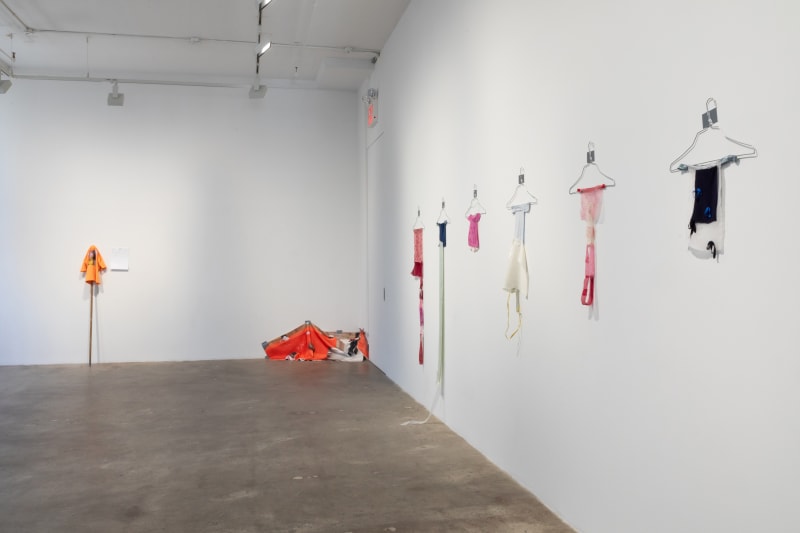Chang Yuchen, Paige Landesberg, Shanzhai Lyric
January 28—February 1, 2020
Opening: Tuesday, 1/28, 6-8PM
Book launch: Friday, 1/31, 6-8PM
Closing event: Saturday, 2/1, 6-8PM
HESSE FLATOW
508 West 26th Street, Suite 5G
New York, NY 10001
Inquiries: info@hesseflatow.com
A “good” shop window, like a “good” advertisement, organizes its selection of goods so that they appear to meet the (psychologically) unique needs of the person who gazes upon them. A spectator standing in front of a show window…feels his perception disturbed if other people are trying to occupy his particular position, or if he becomes too aware of other showcase displays and the people responding to them.1
Like many other art spaces in New York, Hesse Flatow will play host to the tidal wave of events associated with the annual Fashion Week. And, heart on sleeve, the gallery program corresponds in turn with its own five-day fashion show which opens a dialogue surrounding the identity-forming aspirations of material culture through responses to the roles of maker and consumer, and the missed connections between.
Negotiating a landscape of objects built to be discarded—from fast-food wrappers and street signage to cans of Crazy Stallion and kiddie motor-bikes—Paige Landesberg photographs urban debris in the effort to discover a functional, de-aestheticized sculptural relationship in such found accumulations. Re-printed as banners on vibrant swathes of terry cloth towel, the patchy images also evoke the elongated rectangular signage of store banners, truck trailers, or billboards. Marketing the towels changeably as wearables and as beach accessories, Landesberg plays into the behavior of “window shopping identity”—as worded by Barrett Avner, Contain—however, with objects that both elicit a desire to consume and indicate the waste that consumption produces.
Use Value, a brand designed and handmade entirely by Chang Yuchen, also responds to the relationship between body and environment in the creation of protective if exquisitely delicate aprons and masks. These gauzy, tenuous barriers signal the precarity of labor when tied to the utopic ambitions of artistic labor and love. Priced to reflect the cost of materials and time spent on each object in relation to all previous hourly rates that Chang has earned, the works reinforce the reality of artist as material producer contending with the economic reality of a bottom line. At the same time, Chang’s patterned, fabric assemblages bring art into the intimate sphere of articles meant to accumulate the splashy, sticky stains of the body and all that it encounters.
An installation of shanzhai shirts—the Chinese term for counterfeit or imitation goods—pokes both facetiously and earnestly at language poetics in a globalized and glitchy contemporary. Collected and curated by Ming Lin and Alexandra Tatarsky, the shirts bear a syncopated rhythm of misspelled words and syntactical incongruities, which underline the lost translation and unintentional illegibility of an anonymous maker, the garbled utterances of capital’s ghost.
The exhibition title—in part tipped hat to the ingenious name of Avner’s LA-based label—suggests the vague authorship of the boundaries that fortify our bodies and psychic selves, objects acting dubiously as a constellation of identity-signifiers and as traces of makers and consumers unknown.
In addition to the opening reception, the exhibition will host two further events. On Friday, January 31, Hesse Flatow’s first publication Twelve Month Crush will be launched. In the spirit of a dialogue on practice and experience, Karen Flatow joined forces with curator Nicole Kaack to found a conversation series that ran in tandem with the 2017-2018 season of CRUSH Curatorial. Twelve Month Crush compiles these variably public and intimate conversations alongside contributions by the artists exhibited that year. Founded in 2016 CRUSH was spurred by a desire to create opportunities for exhibition and conversation with an intergenerational community of emerging artists.
Finally, as closing celebration and de-install, on Saturday, February 1, Paige Landesberg will choreograph movement of fabric tableaus of city sidewalks and disposable bags, pragmatically deconstructing the exhibition, alongside a painters' ballet that will take place over 8 minutes and 30 seconds.
1Dan Graham, “Notes on Video Piece for Showcase Windows in a Shopping Arcade,” in Two Way Mirror Power, ed. Alex Alberro, (Cambridge, Massachusetts: MIT Press, 1999), 49.

